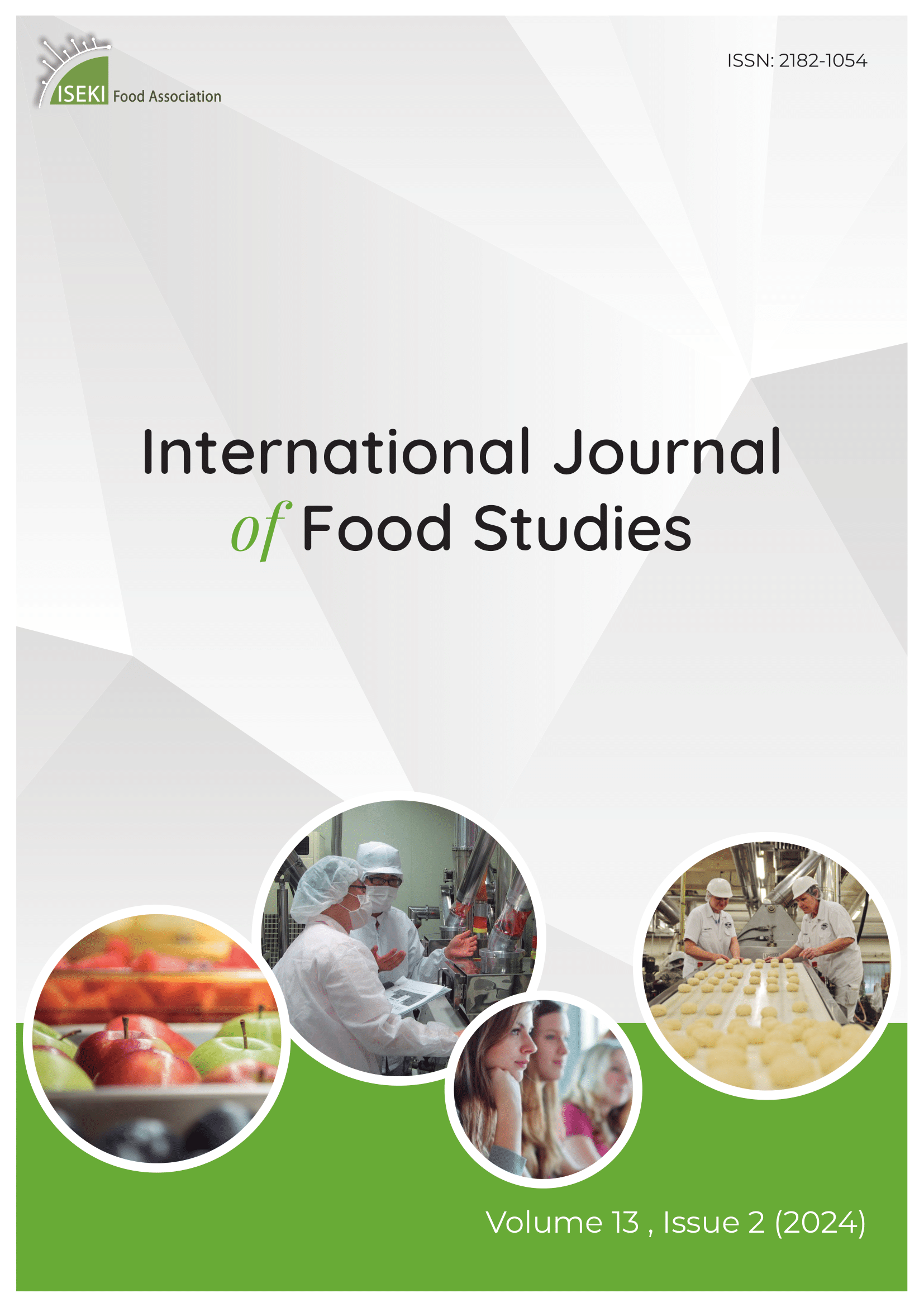Current issue

Volume 13, Issue 2, 2024
Online ISSN: 2182-1054
Volume 13 , Issue 2, (2024)
Published: 18.10.2024.
Open Access
All issues
Contents
01.12.2018.
Professional paper
Physico-chemical composition and antimicrobial protein content of early lactation donkey milk
Maria Aspri, Kallis Souroullas, Christina Ioannou, Photis Papademas
01.12.2018.
Professional paper
Non-fermented synbiotic drink based on lactic cheese whey which incorporates Lactobacillus rhamnosus GG and Lactobacillus paracasei
Sima Taheri, Morteza Khomeiri, Mehran Aalami, Ali Moayedi
01.12.2018.
Professional paper
Consumer awareness of the use of food labels in Lagos state, Nigeria
Samuel T. Danilola, Olubunmi A. Omotesho, Jubril Animashaun
01.12.2017.
Professional paper
Examination of optimum test conditions for a 3-point bending and cutting test to evaluate sound emission of wafer during deformation
Erdem Carsanba, Gerhard Schleining
01.12.2017.
Professional paper
Are we doing our homework? An analysis of food engineering education in Brazil
Vivian-Lara Silva, Fausto Makishi, Marcus Magossi, Izabel Cristina Freitas Moraes, Carmen Silvia Fávaro Trindade, Paulo José Do Amaral Sobral
18.10.2018.
Original scientific paper
Antioxidant activities of aqueous extracts from nine different rose cultivars
Rose petals have been applied as food additives in teas, cakes and flavor extracts. The aim of this research study was to explore and reveal the antioxidant potential of aqueous extracts of rose petals belonging to nine genotypes of rose (wild as well as hybrid). The in vitro antioxidant activities of roses were studied by lipid peroxidation assay, DPPH radical scavenging assay, iron chelation assay, phosphomolybdenum reduction assay and total phenolic and flavonoid contents. The aqueous extract showed inhibition against lipid peroxidation (TBARS), induced by prooxidants (10 µM FeSO4) in mice liver homogenate. The free radical scavenging activities of the extracts were determined by scavenging of the DPPH radical. Extracts also showed metal chelating activities and high antioxidant activity in the phosphomolybdenum assay. The high content of phenolics and flavonoids detected in aqueous extracts may be responsible for the antioxidant activity. Amongst the different rose genotypes, screened, Rosa moschata (musk rose) was found to carry slightly higher antioxidant potential, owing to its higher phytochemical content.
Hamadia Khurshid, Syed Mubashar, Shahid Iqbal Awan, Syed Rizwan Abbas, Muhammad Irshad
18.10.2018.
Original scientific paper
Food safety implementation in the perspective of network learning
The food sector frequently faces difficulties in implementing food safety standards. Indeed, there are many barriers to appropriation of quality management standards which make effective implementation difficult for small and medium enterprises (SMEs), such as limited access to information, lack of financing and cognitive resources, food hazard perception, and insufficient access to adequately trained personnel. Consequently, one fundamental objective for practitioners such as managers, public bodies and development agencies is to help these food SMEs in improving their implementation capacity, which is usually done through the launch of different forms of collective initiatives such as associations, clubs, learning platforms, regional actions and other forms of collaboration. Globally speaking, the objective of these initiatives typically is to develop a step by step approach providing guidance on good practices associated with the implementation of these systems. The objective of the article is to explore and test the validity of this hypothesis, rooted in a general idea of “organizational network learning”: the capacity of SMEs to adopt new food safety schemes is seen as a whole and necessitates mobilizing, at the same time, 1) formal innovation networks, which bring cognitive resources and institutional credibility, and 2) the practice by managers of informal network activities through interactive exchanges of information, benchmarking, knowledge transfer and translation, and experiential learning.
Zam-Zam Abdirahman, Leslie D. Bourquin, LOIC SAUVEE, Deepa Thiagarajan
18.04.2018.
Original scientific paper
Optimization of osmotic dehydration of chestnut (Castanea sativa Mill.) slices using Response Surface Methodology
Osmotic dehydration of chestnut slices in sucrose was optimized for the first time by Response Surface Methodology (RSM). Experiments were planned according to a three-factor central composite design (α=1.68), studying the influence of sucrose concentration, temperature and time, on the following parameters: volume ratio, water activity, color variation, weight reduction, solids gain, water loss and normalized moisture content, as well as total moisture, ash and fat contents. The experimental data was adequately fitted into second-order polynomial models with coefficients of determination (R2 ) from 0.716 to 0.976, adjusted-R2 values from 0.460 to 0.954, and non-significant lacks of fit. The optimal osmotic dehydration process conditions for maximum water loss and minimum solids gain and color variation were determined by the “Response Optimizer” option: 83% sucrose concentration, 20 °C and 9.2 hours. Thus, the best operational conditions corresponded to high sugar concentration and low temperature, improving energy saving and decreasing the process costs.
Teresa Delgado, Bruna Paim, Jose Alberto Pereira, Susana Casal, Elsa Ramalhosa
18.10.2018.
Original scientific paper
Extraction kinetics of saponins from quinoa seed (Chenopodium quinoa Willd)
Quinoa has higher protein content (11-16% m/m) and better amino acid profile than cereals and represents a valuable resource for healthy nutrition. The aim of this work was to study the saponins extraction kinetics during washing of soaked quinoa. The experimental curves of saponins content as a function of time was measured at water temperatures of 20, 40, 60, and 70ºC. A spectrophotometric method was proposed to determine total saponins content, while an unsteady state diffusional model was applied to this extraction problem, assuming strict internal control to the mass transfer rate. As a first analysis, the complete analytical solution for constant diffusion coefficient (Deff) using the initial radius (R0) provided an accurate predicted curve at each temperature. The diffusion coefficients (around 10−10 m2s-1), were correlated with temperature using an Arrhenius-type relationship to obtain an activation energy Ea of 16.9 kJ mol-1. The preliminary values of Ea and preexponential factor (D0) thus obtained were used as initial values of a second, more robust fitting where the whole dataset of saponins concentrations as a function of time for all temperatures. The Arrhenius equation was directly inserted into the diffusional solution. The following parameters were obtained: Ea= 17.2 kJ mol-1 and, D0= 3.232×107 m2 s-1, respectively with an overall r2=0.985. Saponins content agreed well with experimental values. As the equation is capable of predicting saponin extraction times for various operating conditions, it can be used within equipment design schemes.
R. M. Torrez Irigoyen, Sergio Giner
01.12.2017.
Professional paper
Energy pattern and conservations of condiment produced from soybean (Glycine max)
Ismaila B. Anjorin, Rahman Akinoso, Mayowa S. Sanusi











